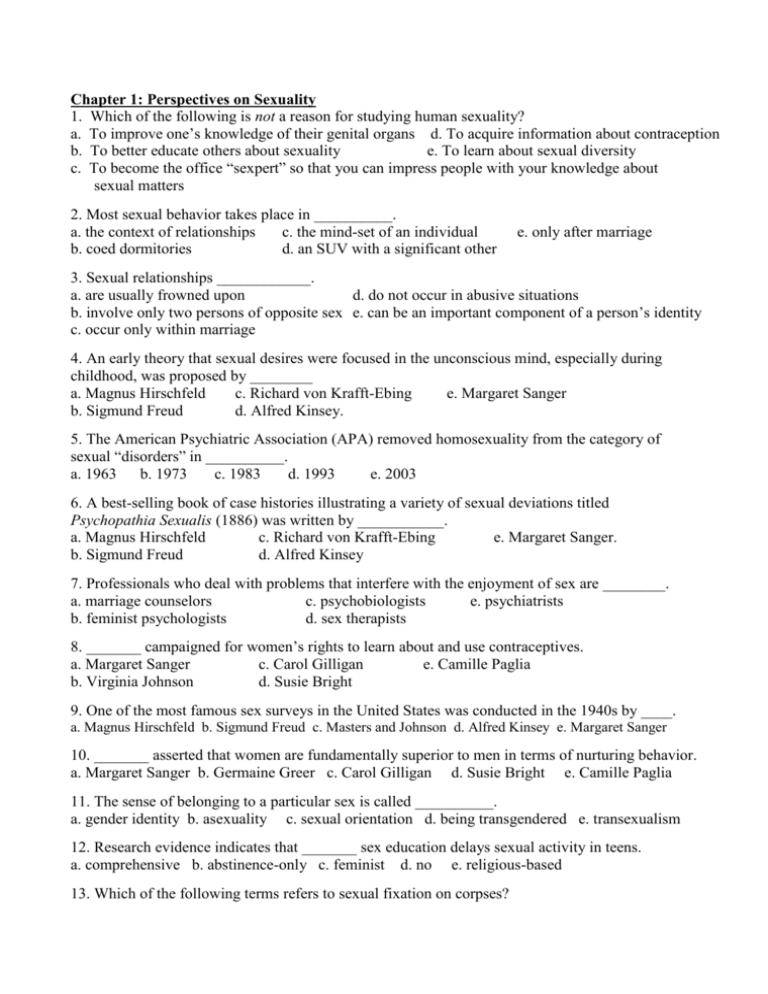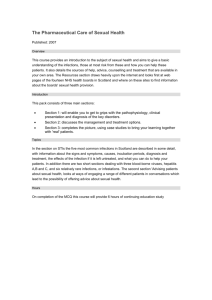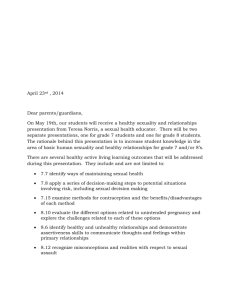
Chapter 1: Perspectives on Sexuality
1. Which of the following is not a reason for studying human sexuality?
a. To improve one’s knowledge of their genital organs d. To acquire information about contraception
b. To better educate others about sexuality
e. To learn about sexual diversity
c. To become the office “sexpert” so that you can impress people with your knowledge about
sexual matters
2. Most sexual behavior takes place in __________.
a. the context of relationships
c. the mind-set of an individual
b. coed dormitories
d. an SUV with a significant other
e. only after marriage
3. Sexual relationships ____________.
a. are usually frowned upon
d. do not occur in abusive situations
b. involve only two persons of opposite sex e. can be an important component of a person’s identity
c. occur only within marriage
4. An early theory that sexual desires were focused in the unconscious mind, especially during
childhood, was proposed by ________
a. Magnus Hirschfeld
c. Richard von Krafft-Ebing
e. Margaret Sanger
b. Sigmund Freud
d. Alfred Kinsey.
5. The American Psychiatric Association (APA) removed homosexuality from the category of
sexual “disorders” in __________.
a. 1963
b. 1973
c. 1983
d. 1993
e. 2003
6. A best-selling book of case histories illustrating a variety of sexual deviations titled
Psychopathia Sexualis (1886) was written by ___________.
a. Magnus Hirschfeld
c. Richard von Krafft-Ebing
e. Margaret Sanger.
b. Sigmund Freud
d. Alfred Kinsey
7. Professionals who deal with problems that interfere with the enjoyment of sex are ________.
a. marriage counselors
c. psychobiologists
e. psychiatrists
b. feminist psychologists
d. sex therapists
8. _______ campaigned for women’s rights to learn about and use contraceptives.
a. Margaret Sanger
c. Carol Gilligan
e. Camille Paglia
b. Virginia Johnson
d. Susie Bright
9. One of the most famous sex surveys in the United States was conducted in the 1940s by ____.
a. Magnus Hirschfeld b. Sigmund Freud c. Masters and Johnson d. Alfred Kinsey e. Margaret Sanger
10. _______ asserted that women are fundamentally superior to men in terms of nurturing behavior.
a. Margaret Sanger b. Germaine Greer c. Carol Gilligan d. Susie Bright e. Camille Paglia
11. The sense of belonging to a particular sex is called __________.
a. gender identity b. asexuality c. sexual orientation d. being transgendered e. transexualism
12. Research evidence indicates that _______ sex education delays sexual activity in teens.
a. comprehensive b. abstinence-only c. feminist d. no e. religious-based
13. Which of the following terms refers to sexual fixation on corpses?
a. Coprophilia
b. Bestiality
c. Sadism
d. Necrophilia
e. Sexual murder
14. Evolutionary psychologists believe that genes cause females to be _______ about their choice
of sex partners.
a. picky b. careless c. indifferent
d. risky e. delayed
15. Masters and Johnson’s book _______ describes techniques for ameliorating sexual problems.
a. On Our Backs
d. Psychopathia Sexualis
b. Human Sexual Inadequacy
e. Sexual Behavior in the Human Female
c. Our Bodies, Ourselves
Chapter 2: Sex and Evolution
1. Traits that are passed down from parents to offspring are termed __________.
a. heritable b. conjugations
c. eukaryotes
d. gametes
e. parthenogenic
2. Scientists estimate the number of genes in the human genome to be between
a. 44 and 46
c. 20,000 and 25,000
e. 50 million and 100 million
b. 500 and 5000
d. 1 million and 2 million
3. Which of the following is famous for forming lifelong pair bonds?
a. Rabbits b. Swans c. Ducks
d. Bears
e. Lizards
4. A single female with a harem of males is a social relationship called _________.
a. monogamy b. polyamory c. polygyny
d. polyandry
e. promiscuity.
5. When a male remains close to a female throughout her fertile period and keeps other males away
from her, he is ___________.
a. mate guarding b. acting foolishly c. condoning female promiscuity d. sterile e. past his sexual prime
6. In mammals, when an ovum and sperm fuse at fertilization, a female offspring results if the
ovum receives _______ from the sperm.
a. a Y chromosome
c. both an X and Y chromosome
e. two Y chromosomes
b. an X chromosome
d. two X chromosomes
7. The process of splitting in two, by which microscopic, single-celled organisms reproduce, is
termed ________.
a. sexual reproduction b. copulation c. having sex d. binary fission
e. conjugation
8. The willingness of animals, including humans, to engage in sex outside of an established
relationship is termed __________.
a. pornography b. prostitution
c. promiscuity d. polygamy e. adultery
9. The key feature of sexual reproduction is that ____________.
a. offspring carry a mixture of genes from both parents
b. it occurs when females outnumber males
c. it occurs when males outnumber females
d. it increases the occurrence of mutations in a species
e. it is less adaptive than asexual reproduction
10. The final product of mitosis is _________.
a. haploid gametes
c. diploid gametes
e. haploid polymorphisms
b. haploid daughter cells
d. diploid daughter cells
11. The mixing of _______ might be useful in adapting to environmental change.
a. genes b. hormones c. gonads
d. eukaryotes e. MHC markers
12. According to disruptive selection, individuals not favored are those that produce ________.
a. small gametes b. large gametes c. middle-sized gametes d. too many gametes e. haploid gametes
13. There are no known species in which individual organisms have more than _______ parents.
a. 2 b. 3 c. 1 d. 4
e. 5
14. A mature female gamete prior to fertilization is called a(n) __________.
a. zygote
b. isogamete
c. ovum
d. daughter cell
e. chromatid.
15. At every stage in development _______ are more likely to die than _______.
a. boys, girls
d. eukaryotic organisms, single-celled organisms
b. girls, boys
e. multi-celled organisms, single-celled organisms
c. sexual species, asexual species
Chapter 3: Women’s Bodies
1. The structures that comprise the vulva include all of the following except the _______.
a. mons veneris b. labia majora c. labia minora d. vestibule
e. anus.
2. The clitoral hood is formed from the _________.
a. labia majora b. labia minora c. glans of the clitoris
d. shaft of the clitoris
e. vestibule
3. The fatty folds of skin that run down from the mons on either side of the vulva are the ______.
a. labia minora b. labia majora c. vestibules
d. inner lips
e. pubic symphysis.
4. The only certain function of the clitoris is to _________.
a. provide excitement for the male
d. mediate orgasm
b. aid retention of sperm
e. help a woman to conceive
c. provide sexual pleasure for the female
5. The mucosal surface of the vagina normally has a pH value of _________.
a. 4.0–5.0 b. 6.0–7.0
c. 8.0–9.0
d. 0.0–1.0
e. 2.0–3.0.
6. Menstrual blood comes from the _______ layer of the uterus.
a. myometrial b. endometrial c. peritoneal
d. cervix
e. urethral
7. The portion of the oviduct consisting of a fringe of finger-like extensions is the ________.
a. isthmus
b. ampulla c. infundibulum d. fimbria
e. crura.
8. Contraction of the _______ causes the clitoral glans to hide under the clitoral hood.
a. bulbospongiosus muscle b. ischiocavernosus muscle c. Kegel muscles d. crura
e. prepuce
9. A hymen with numerous small openings is called _________.
a. annular b. septate
c. cribriform
d. imperforate
e. absent
10. The uterine condition in which the uterus sags downward into the vagina is called ________.
a. fibroids b. endometriosus
c. hysterectomy d. uterine prolapse e. menarche
11. Milk-secreting cells of the breasts are arranged around small cavities called _________.
a. alveoli b. nipples c. areolae
d. lobules
e. fat tissue
12. All of the following are risk factors for developing breast cancer except ___________.
a. BRCA1 gene mutations
c. early menopause
e. old age
b. early menarche
d. postmenopausal hormone therapy
13. Surgical removal of a breast lump and some surrounding healthy tissue is referred to as a ____.
a. biopsy b. lumpectomy c. mastectomy d. radical mastectomy e. mammography
14. When a woman is in a sexually nonaroused state, the vaginal mucosa appear ________.
a. pink b. white c. purple d. clear
e. yellow
15. A microscopic examination of cells from the cervix is called a __________.
a. Pap test b. pelvic exam
c. laparoscopy d. colposcopy e. mammogram
Chapter 5: Sex Hormones and the Menstrual Cycle
1. Despite individual differences in the length of the menstrual cycle, which phase is the most constant?
a. Menstrual b. Follicular c. Preovulatory d. Luteal
e. Ovulatory
2. Pain experienced at the time of ovulation is called _________.
a. mittelschmerz b. dysmenorrhea c. primary amenorrhea d. secondary amenorrhea e. endometriosis
3. In the testes, testosterone is produced by the _______ cells.
a. Leydig b. Sertoli
c. thecal
d. granulosa
e. inhibin
4. Sex steroids are _______ molecules derived from _______.
a. lipid; cholesterol
c. protein; cholesterol
e. cholesterol; amino acids
b. lipid; amino acids
d. protein; amino acids
5. Ovulation occurs _________.
a. about 14 days before the menstrual phase begins
b. about 5 days after the menstrual phase ends
c. during the menstrual phase
d. during the luteal phase
e. during the follicular phase.
6. In women, the main source of estradiol is the _________.
a. brain b. uterus
c. vagina
d. cervix
e. ovarian follicles
7. A hormone from the hypothalamus that triggers milk letdown is ________.
a. dopamine b. serotonin c. estrogen d. progesterone
e. oxytocin.
8. GnRH is released from the _________.
a. gonads b. testes
c. ovaries
d. hypothalamus
e. pituitary.
9. Estradiol in mens' bodies __________.
a. is produced from testosterone
d. maintains bone density
b. facilitates the maturation of sperm
e. All of the above
c. terminates the growth of the limb bones at the conclusion of puberty.
10. The system of glands that secretes hormones into the bloodstream is the _______ system.
a. nervous b. reproductive
c. endocrine
d. anabolic
e. metabolic
11. The uterus is prepared for pregnancy __________.
a. during menstruation
d. at ovulation
b. at the time of sexual intercourse
e. during the follicular phase of the menstrual cycle.
c. during the luteal phase of the menstrual cycle
12. Which of the following is not an example of a sex steroid hormone?
a. Testosterone b. DHT
c. Estradiol
d. Progesterone
e. Dopamine
13. In men and women, testosterone is secreted by the gonads and the _________.
a. testes
b. ovaries
c. adrenal glands
d. hypothalamus
e. pituitary.
14. Before it starts to develop, an oocyte with its surrounding granulosa cells is referred to as a(n) ____.
a. antrum
b. antral follicle c. primary oocyte
d. preantral follicle e. primordial follicle
15. Excessive menstrual bleeding is known as _______.
a. primary amenorrhea b. secondary amenorrhea c. dysmenorrhea d. menorrhagia e. oligomenorrhea
Chapter 4: Men’s Bodies
1. The rigidity and stiffness of the penis is due mainly to blood flowing into the _________.
a. corpora cavernosa
c. penile bones
e. suspensory ligament
b. corpus spongiosum
d. pelvic cavity
2. Sperm account for about _______% of the total volume of semen.
a. 70 b. 30
c. 20 d. 10
e. 1
3. Circumcision is an ancient practice that is religiously prescribed for _________.
a. Catholics b. Protestants c. Muslims and Jews d. Atheists
e. married men.
4. Sperm production occurs in the _________.
a. rete testis b. epididymis
c. seminiferous tubules
d. Leydig cells
e. prostate gland
5. The process of seminal _______ involves the loading of semen into the urethra.
a. erection b. ejaculation
c. emission d. emotion
e. conservation
6. _______ is inflammation of the glans penis.
a. Phimosis b. Paraphimosis
c. Peyronie’s disease
d. Balanitis
e. Penile cancer
7. _______ protect sperm from the acidic environment of the vagina.
a. Acids b. Sugars c. Buffers d. Enzymes
e. Fibrinogen
8. A(n) _______ is surgical removal of the testis.
a. orchiectomy b. hysterectomy c. circumcision
d. torsion
e. oopherectomy
9. _______ cancer is the commonest non-skin cancer among American men.
a. Testicular b. Prostate c. Scrotal
d. Penile
e. Anal
10. The opening of the urethra is known as the _________.
a. perineum b. meatus
c. glans
d. frenulum
e. prostate
11. Another term for Leydig cells is _________.
a. interstitial cells b. Sertoli cells
c. sperm
d. diploid
e. haploid
12. Another term for Cowper’s glands is _________.
a. vas deferens b. seminal vesicles c. prostate glands
d. bulbourethral glands
13. The _______ of the sperm contains mitochondria and provides energy.
a. midpiece b. acrosome c. flagellum d. tail
e. seminal fluid
14. The brain region important for regulating erections is the _______.
a. locus coeruleus b. medulla c. pons d. hypothalamus
e. pituitary.
15. Each contraction during ejaculation lasts about _______.
a. 1 second b. 0.001 seconds c. 0.01 seconds d. 0.1 seconds
e.10 seconds.
e. epididymis







